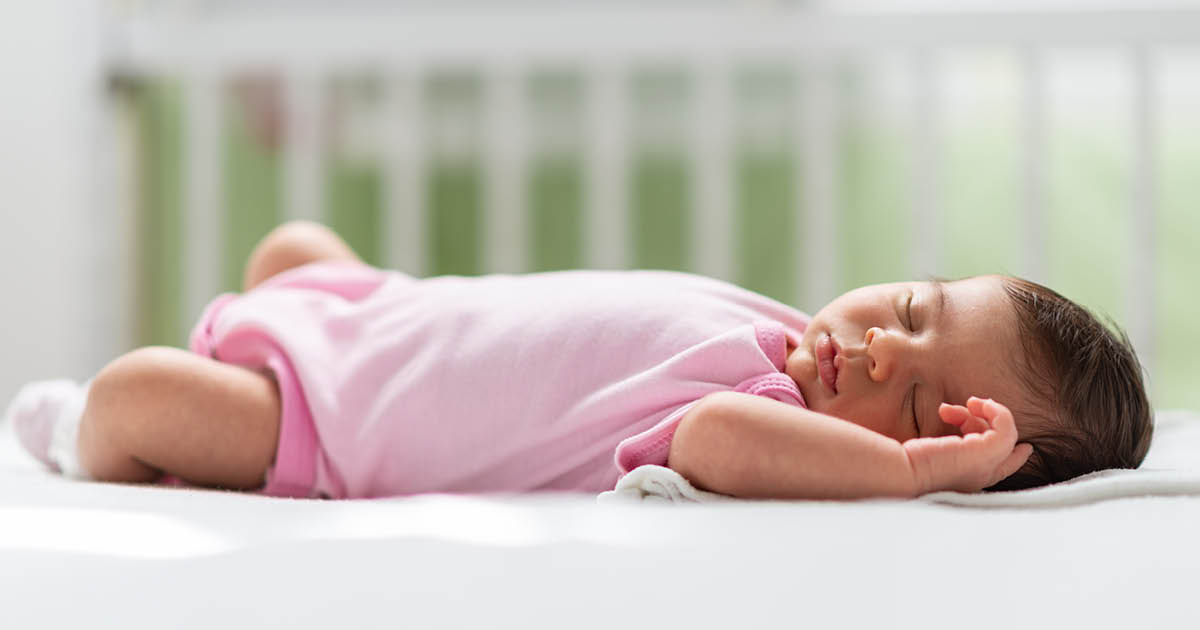October marks Safe Sleep Awareness Month, which aims to reduce the risk of sleep-related infant deaths. According to the Centers for Disease Control and Prevention (CDC), more than 3,500 babies in the U.S. die suddenly and unexpectedly every year while sleeping, often due to sudden unexpected infant death (SUID). The most common types of SUID include sudden infant death syndrome (SIDS) and accidental death from suffocation or strangulation. The sad reality is the vast majority of these deaths are completely preventable.
We sat down with Sanjuanita Garza-Cox, M.D., to discuss how efforts by the American Academy of Pediatrics (AAP) have resulted in a marked decline in SUID deaths, how to create a safe sleep environment for baby and the importance of educating caregivers on safe sleep methods. Dr. Garza-Cox is a neonatologist at Methodist Children’s Hospital in San Antonio, Texas. Additionally, she serves as president of Baby Education for South Texas and is a member of the Texas Department of State Health Services’ Texas Child Fatality Review team.
Education is key to prevention
Over the last three decades, the number of sleep-related infant deaths has declined by about 40%. Dr. Garza-Cox says the reduction is largely a result of the AAP’s safe sleep recommendations and the various measures they’ve put in place over the years. The effort began in 1992 when the AAP issued the recommendation that babies sleep on their backs or sides to reduce the risk of SIDS (a statement revised in 1996 to say only the back was safest). In 1994, the National Institute of Child Health and Human Development launched the “Back to Sleep” campaign (now known as the “Safe to Sleep” campaign), which significantly reduced the percentage of babies sleeping on their stomachs. For the last 25 years, the AAP has released various policies with new or updated recommendations, with the latest policy released in 2016.
Still, most of the deaths (more than 60%) are due to suffocation and strangulation in bed either due to the use of soft bedding or co-sleeping. In 2019, the AAP released an article on the prevalence and factors associated with safe infant sleep practices, which surveyed mothers on how they were putting their babies to sleep. Nearly 80% reported putting their infants to sleep on their backs, and almost 60% reported room-sharing without bed-sharing. A much lower percentage of mothers reported avoiding soft bedding and using a separate approved sleep surface. While parents are doing a good job of putting babies to sleep on their backs, we must be more diligent about creating an overall safe sleep environment.
Creating a safe sleep environment
Dr. Garza-Cox advises parents to abide by the following AAP safe sleep recommendations until the baby is a year old:
- Place baby to sleep on their back for all sleep times (naps and at night)
- Do not place baby on an incline, including infants who suffer from gastroesophageal disease (GERD). It’s a common misconception that laying GERD babies on their abdomen can prevent them from choking on secretions. However, the trachea lays on top of the esophagus, and when lying on the back, it sits above the esophagus. There is no evidence that if a baby spits up while on their back, it will block the trachea, but if a baby is placed on their abdomen, secretions can pool, enter the trachea and lead to choking.
- Put baby to bed in one-piece pajamas, with only one piece of clothing more than what the parent is wearing to prevent overheating, and avoid hats as they can become displaced and cover baby’s face
- Place baby on a firm sleep surface
- Consider room sharing for the first 6-12 months
- Use the bed only for feeding or comforting
- Avoid bed sharing
- Keep soft items and loose bedding out of the bed area
- Give baby a pacifier once breastfeeding has been established
- Swaddle baby with their hands by their face so they can soothe themselves, typically until they are 2-4 months old and have begun to roll over
Dr. Garza-Cox also notes that exclusive breastfeeding for the first 6-12 months can reduce the risks of SIDS as well as regular skin-to-contact contact (so long as parents are alert and awake). Daily tummy time is also important to help with baby’s motor development and prevent flat head syndrome.
Many sleep products on the market today are attractive to parents but are unsafe or unreliable, providing a false sense of security. Dr. Garza-Cox advises parents to carefully review these products to ensure they meet the above AAP safe sleep environment standards. For example, the popular wearable sleep monitors have not been studied to prove their benefits or risks. Dr. Garza-Cox notes that many years ago, babies were sent home from the hospital on medical-grade monitors, but they were never proven to prevent SIDS and many infants died while using them. So, parents should consider that a device lacking Food and Drug Administration (FDA) approval may not be truly effective.
Empowering caregivers
Given that many children are cared for by people other than their parents, it is critical for parents who are knowledgeable about and support safe sleep practices to educate caregivers. Dr. Garza-Cox recommends having a written contract signed by the caregiver that binds them to follow safe sleep practices for their child. While commercial daycares are state regulated and require training for providers, home-based daycares do not have those same regulations, and many are not licensed. Even family members such as grandparents should be instructed on current practices since guidelines have changed from how they put their children to sleep many years ago.
Can't find time to read? Listen instead!
